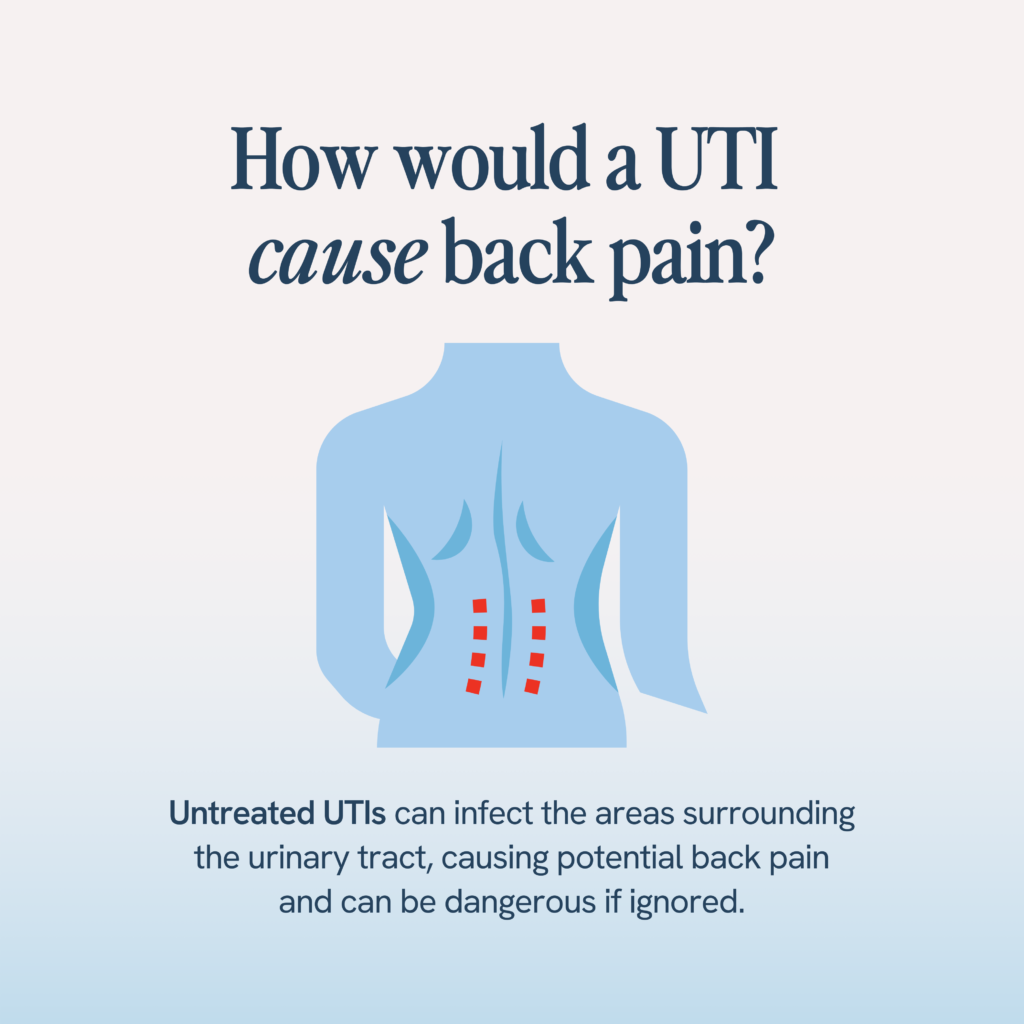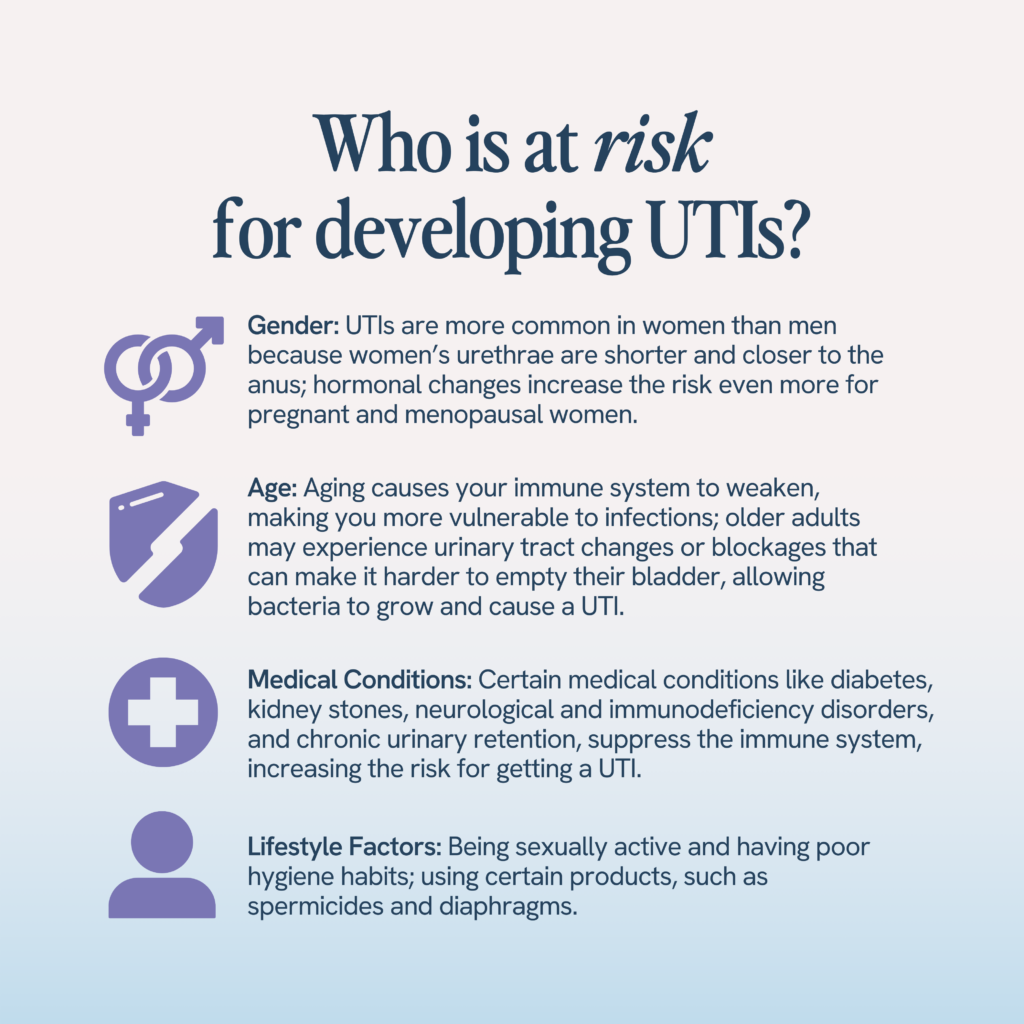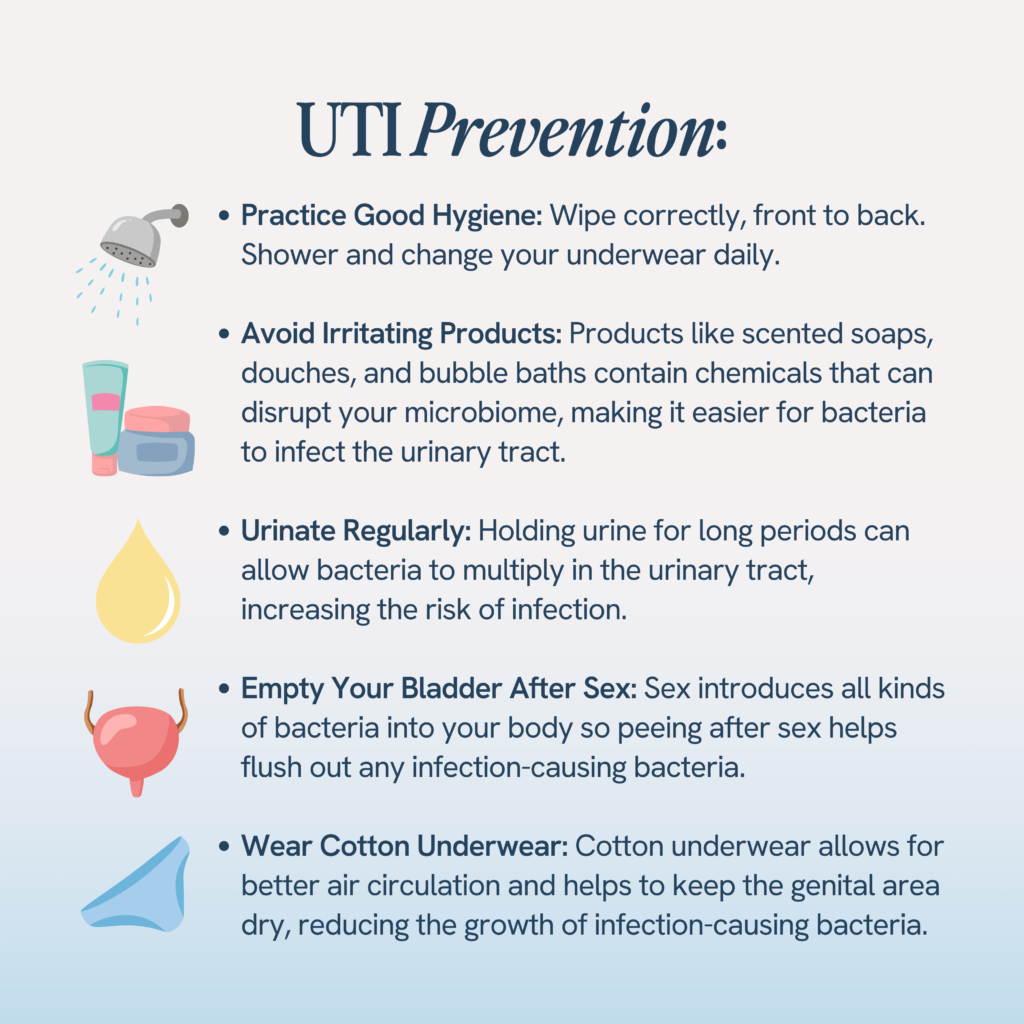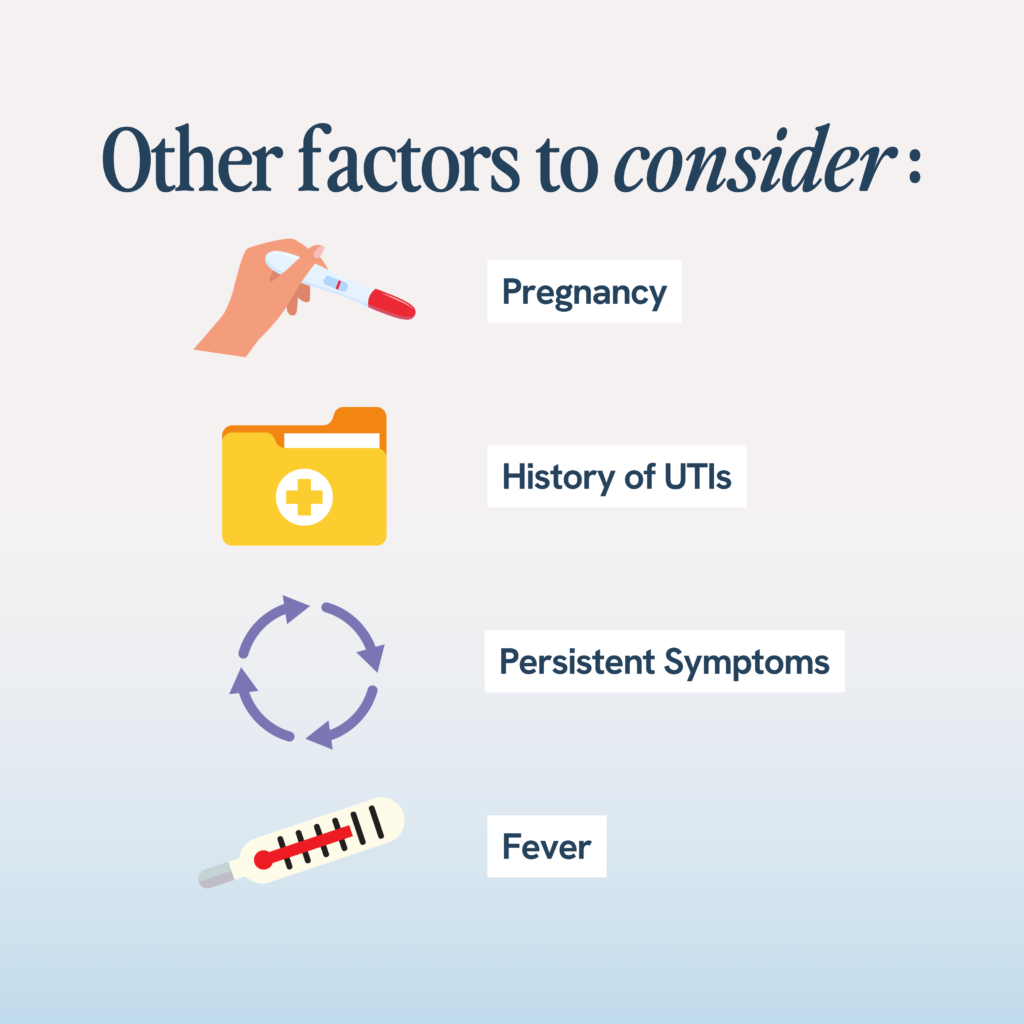- UTI back pain is serious. It indicates that the infection has spread beyond the urinary tract and into the kidneys and/or the surrounding tissue.
- Monitor yourself for mild UTI symptoms to catch urinary tract infections sooner rather than later.
- A doctor can assess the severity of your infection and put you on the right course for treatment.
- Practicing good hygiene, such as wiping front to back and wearing clean underwear daily, can reduce the risk of recurrent UTIs.

We all know the tell-tale signs of urinary tract infection or UTI: burning and stinging while peeing and the frequent urge to urinate. But did you know there is a link between back pain and UTIs?
Of course, everyone’s body is different, and not all UTIs lead to back pain. But if you are experiencing new and frequent back pain, it may be worth investigating. Let’s dive into it further.
How would a UTI cause back pain?

A urinary tract infection is caused when a bad bacteria infects a part of your urinary tract, usually your urethra and/or your bladder. But if left untreated, that UTI can infect the areas surrounding the urinary tract, causing potential back pain. This generally occurs once the UTI has spread to the kidneys, causing inflammation and irritation of the surrounding tissue.
When UTIs spread beyond the urinary tract like this, it’s considered the most severe form of UTI and can be dangerous if ignored. If you are ever experiencing unexplained back pain, please don’t try to “suck it up.” Seek medical help right away to protect your health and potentially your life.
The back pain associated with UTIs varies from person to person in terms of the type, location, and severity of the pain. Some people may experience a dull ache or pressure in the lower back, while others may feel sharp pains and spasms. In any case, if you are experiencing new pain you can’t explain, call your doctor so they can get to the root cause.
Who is at risk for developing back pain with UTIs?

As we said before, anyone who ignores a UTI is at risk for the infection spreading beyond the urinary tract into the kidneys and causing back pain.
But for the 10% of women who get UTIs annually (or even multiple times a year!) there is a greater risk of back pain with UTI given the sheer frequency of infection1. How do you know if you fall into this 10%? Here are the biggest risk factors.
Gender and Age
Sorry, ladies, when it comes to UTIs, you are not in luck. A study published in the Journal of Clinical Medicine clearly shows that UTIs are more common in women than men.2 And this makes sense when you consider the anatomical difference between men and women. Women’s urethrae are shorter and closer to the anus, making it easier for bad bacteria to enter the bladder. And it’s these anatomical differences combined with hormonal changes that make both pregnant and menopausal women particularly susceptible to UTIs.
Your risk of developing a UTI also increases with age. Aging causes your immune system to weaken, which makes you more vulnerable to all kinds of infections, including those in the urinary tract. Moreover, older adults may experience urinary tract changes or blockages that can make it harder to empty their bladder, allowing bacteria to grow and cause a UTI.
Medical Conditions
Certain medical conditions suppress the immune system, putting people at higher risk for contracting a UTI, as can those that affect the urinary or musculoskeletal systems.
A study published in the journal Urology notes that all of these increase the risk of UTIs:3
- Diabetes
- Kidney stones
- Neurological disorders
- Immunodeficiency disorders
- Chronic urinary retention
Though developing some of these conditions may be unavoidable, UTI risk can be mitigated by creating a management plan with your doctor and sticking to it as much as possible.
Lifestyle Factors
Lifestyle plays a critical role in your overall health. Regarding UTIs and back pain, in particular, there are 3 main lifestyle factors to consider.
- Sexually active women are more likely to develop UTIs.
- Poor hygiene habits, like improper wiping, can increase the risk of bacteria entering the urethra and causing a UTI.4
- Using certain products, such as spermicides and diaphragms, can increase the risk of UTIs.
What are the symptoms of a UTI? How do I treat it?

When it comes to UTIs, you want to catch and treat them as quickly as possible. If you are experiencing back pain due to a UTI, the infection has already spread beyond the urethra and bladder. Earlier symptoms of a UTI include:
- Burning sensation while urinating
- Frequent urination
- Feeling like you need to go, even when your bladder is empty
- Cloudy or strong-smelling urine
If you experience any of these symptoms, call your doctor or gynecologist so they can confirm a diagnosis and check for any co-infections.
Along with back pain, other symptoms of a more severe urinary tract infection include fever, chills, and nausea.

UTI treatment

UTIs are uncomfortable and frustrating, but they are also incredibly common and highly treatable. Let’s talk about some of the most common treatment options.
Antibiotics
One of the most common ways doctors treat UTIs is through a short course of antibiotics. The prescriptions usually last for several days, depending on the severity of the infection and the type of antibiotic prescribed.
Pain Relievers
UTIs involve quite a bit of pain, whether that’s pain while urinating or pain in the lower back. Pain relievers are often recommended to help ease the discomfort.5 These pain relievers are usually taken for just a few days until symptoms subside, thanks to antibiotics or home remedies, which we’ll get into next.
Home Remedies
There are several home remedies to relieve UTI symptoms. These remedies are not meant to replace antibiotics for treating an active UTI infection. They are ways to make antibiotic treatment more effective so you can feel better faster.
Increasing Water Intake
Water intake is important for maintaining health at any time. But when you are trying to get rid of an active UTI, water intake is critical. One study by the University of Miami found that drinking more water helped flush the bad, infection-causing bacteria from the urinary tract.6 Aim to drink at least 8-10 glasses of water daily.
Heat Therapy
If you are dealing with UTI-related back or pelvic pain, a heating pad or warm bath can make a world of difference. One study published in the Journal of Clinical Nursing found that applying heat to the affected area can help to increase blood flow, reduce muscle tension, and decrease pain and discomfort associated with UTIs.7
Cranberry
Cranberries, especially cranberry supplements that contain Pacran®, can help in the treatment of UTIs. That’s because cranberries contain compounds that have been shown to stop bacteria, especially E. coli, from adhering to the walls of the urinary tract.8 This is where the advice to drink cranberry juice came from.
In reality, though, cranberry juice does not have the level of these compounds needed to make an impact. And the levels of added sugars these juices contain can actually make you more susceptible to UTIs. A cranberry supplement, like Happy V’s D-Mannose + Cranberry Stick Packs, will be a much better place to start. It contains the clinically proven Pacran® we mentioned earlier, as well as D-Mannose, which has also been shown to prevent bad bacteria from adhering to the urinary tract.9
UTI prevention

If you have recently experienced a UTI or UTI back pain, it’s not only important to treat your current infection but also to protect yourself from future infections. Here are some of the biggest things you can do to break the cycle of recurrent UTIs.
Practice Good Hygiene
Yes, Virginia, there is a correct way to wipe your butt, and that way is from front to back. A study conducted by researchers at the University of Iowa found that this simple hygiene move can help prevent the transfer of E. coli bacteria from the anal area to the urethra, which can cause UTIs.10
And also, don’t forget other good habits, like showering regularly and changing your underwear daily.
Avoid Irritating Products
Though certain hygiene products may smell incredible, they can do less-than-incredible things when it comes to UTIs. Using products such as scented soaps, douches, and bubble baths can increase the risk of urinary tract infections in women because the chemicals in these products can disrupt your microbiome, making it easier for bacteria to infect the urinary tract.
Urinate Regularly
A study published in the Journal of Urology suggests that holding urine for long periods can allow bacteria to multiply in the urinary tract, increasing the risk of infection.11 So when you have to go, just go.
Empty Your Bladder After Sex
Sex introduces all kinds of bacteria, including E. coli, into your body. That’s why it’s so important to pee after you have sex. The urine will help to flush out any infection-causing bacteria that may have entered the urinary tract.
Wear Cotton Underwear
Silk and nylon are popular choices for underwear, but breathable cotton underwear allows for better air circulation and helps to keep the genital area dry, reducing the growth of bacteria that can cause UTIs.
When should I see a doctor for UTI and back pain?

The short answer: immediately. If you are ever experiencing unexplained back pain, call your doctor right away. When a UTI has spread to your kidneys, causing pyelonephritis, it can lead to sepsis (blood infection) and urosepsis (when a urinary tract infection spreads to the bloodstream) if left untreated.
But back pain is not the only reason to go to your doctor with a suspected UTI. There are other factors to consider, too.
Persistent Symptoms

If you are experiencing symptoms of a mild UTI, like burning while urinating or frequent urination, for more than two days, call your doctor so they can see what’s up.
Fever
A fever is a sign that a UTI has progressed and become more severe and is definitely a signal to seek medical attention.
History of UTIs
Recurrent UTIs are common and can be a vicious cycle. So, if you have recently had a UTI or have a history of recurrent UTIs, previous kidney infections, antibiotic resistance, or bladder or kidney stones, pay attention to signs of an active infection and take action.
Pregnancy
The risk of developing a UTI increases by 2 to 4 times while a woman is pregnant, and approximately 2-10% of pregnant women end up developing a UTI.
And UTIs don’t just add to the overall discomfort of pregnancy; they can be harmful to your baby, leading to premature labor and low birth weight if left untreated.
Final Thoughts

Back pain is a sign of a severe UTI infection and needs a doctor’s attention immediately. Hopefully, though, you can catch and treat the infection well before it gets to this point and take steps to prevent UTIs from recurring.
- Urinary Tract Infection (UTI): An infection in any part of the urinary system, including the kidneys, bladder, ureters, and urethra.
- Pyelonephritis: A severe type of kidney infection usually caused by a bacterial infection that has spread from the bladder.
- Sepsis: A potentially life-threatening condition caused by the body’s response to an infection, leading to organ failure and tissue damage.
- Urosepsis: A type of sepsis caused by a urinary tract infection spreading to the bloodstream.
- D-Mannose: A type of sugar that may help prevent the adherence of certain bacteria to the walls of the urinary tract, potentially reducing the risk of UTIs.
- Microbiome: The collection of microorganisms (bacteria, fungi, viruses) that live in and on the body, contributing to various physiological functions and health outcomes.
- Bono MJ, Leslie SW, Reygaert WC. Urinary Tract Infection. In: StatPearls. Treasure Island (FL): StatPearls Publishing; November 28, 2022. https://www.ncbi.nlm.nih.gov/books/NBK470195/
- Foxman B. (2010). The epidemiology of urinary tract infection. Nature reviews. Urology, 7(12), 653–660. https://doi.org/10.1038/nrurol.2010.190.
- Nicolle LE. Urinary tract infections in special populations: diabetes, renal transplant, HIV infection, and spinal cord injury. Infect Dis Clin North Am. 2014;28(1):91-104. doi: 10.1016/j.idc.2013.09.003. PMID: 24484573. https://pubmed.ncbi.nlm.nih.gov/24484577/
- Hooton, T. M. (2012). Clinical practice. Uncomplicated urinary tract infection. New England Journal of Medicine, 366(11), 1028-1037. https://www.nejm.org/doi/abs/10.1056/NEJMcp1104429
- Little P, Moore MV, Turner S, et al. Effectiveness of five different approaches in management of urinary tract infection: randomised controlled trial. BMJ. 2017;359:j4388. doi:10.1136/bmj.j4388. https://pubmed.ncbi.nlm.nih.gov/20139214/
- Hooton TM, Vecchio M, Iroz A, et al. Effect of Increased Daily Water Intake in Premenopausal Women With Recurrent Urinary Tract Infections: A Randomized Clinical Trial. JAMA Intern Med. 2018;178(11):1509–1515. doi:10.1001/jamainternmed.2018.4204. https://jamanetwork.com/journals/jamainternalmedicine/fullarticle/2705079
- Kızılırmak, S., Karadeniz, G., & Yıldırım, M. (2017). The effect of heat therapy on pain and quality of life in women with urinary tract infection: A randomized controlled trial. Journal of Clinical Nursing, 26(23-24), 4741-4749. doi:10.1111/jocn.13791
- 1. M; FZDD. Cranberry reduces the risk of urinary tract infection recurrence in otherwise healthy women: A systematic review and meta-analysis. The Journal of nutrition. December 2017. Accessed May 7, 2024. https://pubmed.ncbi.nlm.nih.gov/29046404/.
- Porru D, Parmigiani A, Tinelli C, et al. Oral D-mannose in recurrent urinary tract infections in women: a pilot study. Journal of Clinical Urology. 2014;7(3):208-213. doi:10.1177/2051415813518332. https://journals.sagepub.com/doi/abs/10.1177/2051415813518332
- Hooton TM, Scholes D, Hughes JP, et al. A prospective study of risk factors for symptomatic urinary tract infection in young women. N Engl J Med. 1996;335(7):468-474. doi:10.1056/NEJM199608153350703. https://pubmed.ncbi.nlm.nih.gov/8672152/
- Berry SH, Johanson JF, Piper JL, et al. Urinary tract symptoms and residential time following acute urinary tract infection. J Urol. 1993;149(3):483-488. doi:10.1016/s0022-5347(17)36227-4
- A-
- A+






